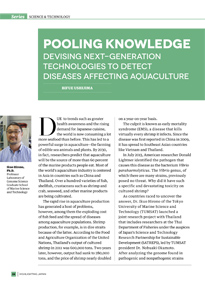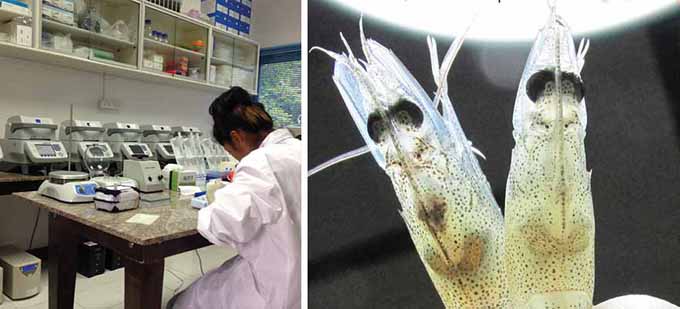Home > Highlighting JAPAN >Highlighting Japan November 2014>Science & Technology
Highlighting JAPAN

Science & Technology
Pooling Knowledge
Devising next-generation technologies
to detect diseases affecting aquaculture

Due to trends such as greater health awareness and the rising demand for Japanese cuisine, the world is now consuming a lot more seafood than before. This has led to a powerful surge in aquaculture—the farming of edible sea animals and plants. By 2030, in fact, researchers predict that aquaculture will be the source of more than 60 percent of the marine products people eat. Most of the world’s aquaculture industry is centered in Asia in countries such as China and Thailand. Over a hundred varieties of fish, shellfish, crustaceans such as shrimp and crab, seaweed, and other marine products are being cultivated.
The rapid rise in aquaculture production has generated a host of problems, however, among them the exploding cost of fish feed and the spread of diseases among aquaculture populations. Shrimp production, for example, is in dire straits because of the latter. According to the Food and Agriculture Organization of the United Nations, Thailand’s output of cultured shrimp in 2011 was 600,000 tons. Two years later, however, output had sunk to 280,000 tons, and the price of shrimp nearly doubled on a year-on-year basis.
The culprit is known as early mortality syndrome (EMS), a disease that kills virtually every shrimp it infects. Since the disease was first reported in China in 2009, it has spread to Southeast Asian countries like Vietnam and Thailand.
In July 2013, American researcher Donald Lightner identified the pathogen that causes this disease as the bacterium Vibrio parahaemolyticus. The Vibrio genus, of which there are many strains, previously posed no threat. Why did it have such a specific and devastating toxicity on cultured shrimp?
As countries raced to uncover the answer, Dr. Ikuo Hirono of the Tokyo University of Marine Science and Technology (TUMSAT) launched a joint research project with Thailand that includes researchers at the Thai Department of Fisheries under the auspices of Japan’s Science and Technology Research Partnership for Sustainable Development (SATREPS), led by TUMSAT president Dr. Nobuaki Okamoto. After analyzing the genome found in pathogenic and nonpathogenic strains of Vibrio bacteria, the team discovered a gene cluster unique to the pathogenic strain in January 2014.
“We determined that the gene structure of pathogenic Vibrio parahaemolyticus contains genes similar to those that produce toxicity in the digestive organs of insects,” Dr. Hirono says. “Because shrimp are also arthropods, when they are exposed to this pathogen their liver, pancreas and other digestive organs change color and undergo necrosis, just like insects subjected to similar toxins.”
The team developed a detection method that targets these genes and rapidly identifies infected shrimp. The Thai Department of Fisheries now uses this method as a standard diagnostic, and offers diagnostic services to shrimp farmers. These developments are expected to lead to solutions that include prevention methods and technologies to remove pathogenic bacteria from seawater.
A different Thai research group has discovered that polychaete worms and bivalves, used as live shrimp feed, are linked to the spread of EMS. Although fish require quarantining before entering a country, live feed is not subject to such measures or import restrictions. This may signify the need for new international regulations on live feed. The Thai researchers and government have expressed strong interest in Japan’s quarantining system, which they view as highly safe.
“Japan is one of the world’s top consumers of seafood, and it leads the globe in terms of aquaculture technology, import safety and the development of vaccines for fish diseases,” Dr. Hirono states. “As the consumption of aquaculture products increases, it is vital for Japan to take the lead in building an international research network to ensure the safety and stability of that output.”
SATREPS researchers are involved in ongoing projects that include the development of selective breeding, alternative feeds, surrogate broodstock technology for aquaculture and other solutions. New aquaculture technologies from Japan are expected to not only solve current food issues such as drops in shrimp production volume and price rises but also to lead the way to a better future for the world’s seafood cuisine—and those who enjoy eating it.
© 2009 Cabinet Office, Government of Japan






